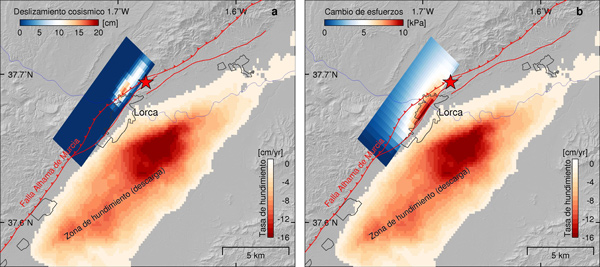
Campus Moncloa
Campus of International Excellence
The subsidence of the city area of Lorca triggered the characteristics of the earthquake in 2011
A collaborative study of the Universidad Complutense de Madrid, Moncloa Campus and the Spanish National Research Council (CSIC) showed a connection between the subsidence of the Lorca area and the characteristics of the tectonic earthquake which hit the town of Lorca on May 11, 2011.
23/10/2012
A collaborative study of the Universidad Complutense de Madrid, Campus of International Excellence Campus Moncloa and the Spanish National Research Council (CSIC) showed a connection between the subsidence of the Lorca area and the characteristics of the tectonic earthquake which hit the town of Lorca on May 11, 2011. The researchers, who published their findings in the Nature Geoscience Journal this week, said that the ground segment that moved during the seism coincided with the adjacent Alto Guadalentin which is an area of groundwater extraction.
The scientific team, who has been analyzing the rates of ground deformation of southeast of the peninsula from satellite images since 2006, has confirmed that the Magnitude 5.1 quake was in the Alhama de Murcia Fault, the most active area. The slip occurred at very shallow depths of 2–3 km.
"The research has revealed for first time that a weight variation over the earth crust, in this case because of the decrease of load by groundwater extraction of the basin of Alto Guadalentín, that registers a subsidence rate of 10 cm per year can control the characteristics of a tectonic earthquake”, said a researcher at the CSIC José Fernández, who works in the Instituto de Geociencias , a joint centre of the CSIC and the Universidad Complutense de Madrid.
In addition to identifying the fault segment that slipped, scientists have developed a load model using historical data of groundwater extraction between 1960 and 2010, as well as the subsidence detected between 1992 and 2007. “This model allowed us to simulate the stress changes accumulated in the crust since the beginning of water extraction and simulate how and where it affected the Alhama de Murcia Fault. Surprising, both models coincided in maximum zones during the earthquake motion and maximum energy storage of groundwater extraction”, said the researchers.
Quantify the seismic risk
According to the researcher Pablo González, from the University of Western Ontario (Canada), the article uses for the first time the physical model that quantifies the variables that involved in the earthquake that triggered “because there was already much tectonic energy in the area”.
The results highlighted that the link between the subsidence caused by water extraction and the type of glide could generally help to understand how and where earthquakes occur. “The study could help to develop enhancements to quantify the seismic risk and to accomplish the maps that are currently used to define the rules of construction”, said González.
Likewise, the research will allow us to limit the conditions required by certain areas of the fault in a way that the rupture associated to an earthquake can start, continue or stop. “In the future, we will have to go in depth the aspects of modeling and the design instrumental networks that allow us to confirm and refine the link between earthquakes” added the scientist.

A model of fault/dislocation of an earthquake estimated from satellite data and GPS, and its link with the detected subsidence area. The rectangle delimits the projection on the fault surface and the color the amount of slip occurred during the earthquake. B A mechanical model of discharge of the crust produced by the groundwater extraction in the area of subsidence detected.
Pablo J. González, Kristy F. Tiampo, Mimmo Palano, Flavio Cannavó y José Fernández. The 2011 Lorca earthquake slip distribution controlled by groundwater crustal unloading. Nature Geoscience. DOI: 10.1038/NGEO1610.
Tag: Global Change and new Energies Source: Universidad Complutense de Madrid
Event date:
23/10/2012
